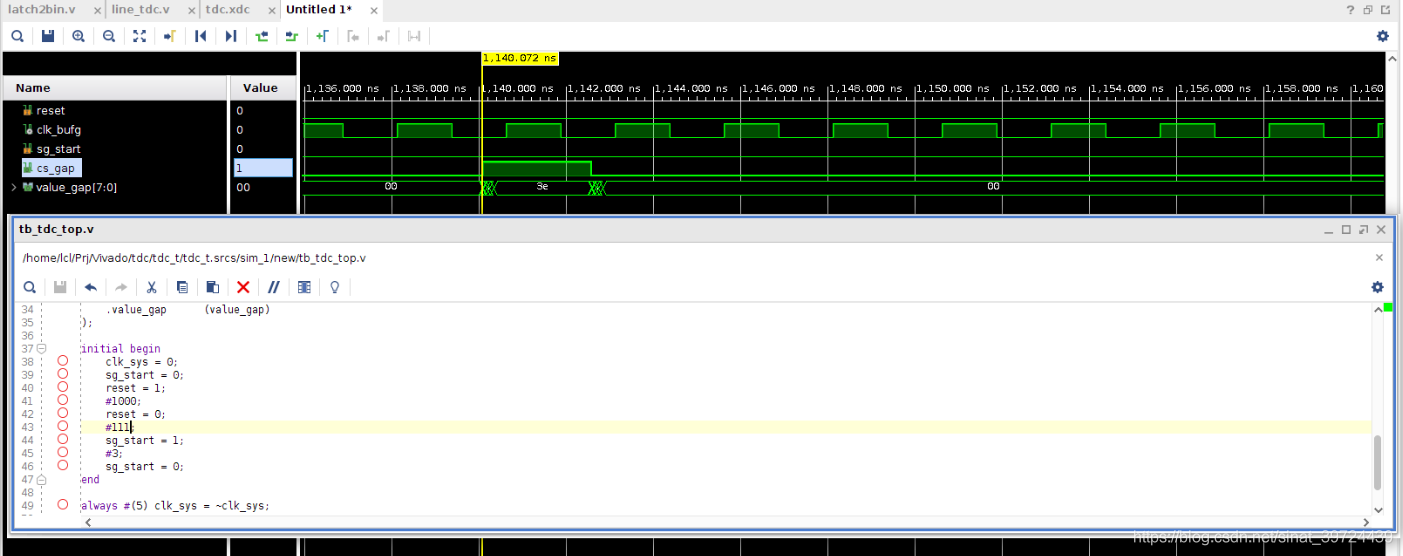

基于FPGA的TDC延时设计方案
电子说
描述
1、参考
https://cas.tudelft.nl/fpga_tdc/TDC_basic.html
2、原理
采用FPGA的CARRY4进位单元,每个CARRY4的COUT连接到下一个CARRY4的CIN,这样级联起来,形成延时链;每个COUT做为抽头输出到触发器,通过本地时钟进行数据采样。假定每个延时链的延时是固定的(最后需要标定),可通过采样值大致估算所测信号与本地时钟上升沿之间的间隔,当得到适当的标定后,可获得较高的精度。
3、当前测试的芯片是XC7K325TFFG900 -2
仿真中的carry4 除第一级外,其他的carry4输出到输入延迟固定都是53ps,但是这是4个进位的延迟时间,只是vivado仿真工具有限制,且需要后仿真。

4、源代码
顶层
tdc_top.v
module tdc_top#(
parameter STAGE = 200,
parameter GAP_BITS = 8
)(
input wire sg_start,
input wire clk_sys,
input wire reset ,
output wire cs_gap,
output wire [GAP_BITS-1:0] value_gap
);
wire clk_bufg;
clk_wiz_0 clk_wiz_0_inst(
.clk_out1(clk_bufg),
.clk_in1(clk_sys)
);
wire valid_pre;
wire valid;
wire [STAGE-1:0] value_latch;
wire bin_cs;
wire [GAP_BITS-1:0] bin;
wire sg_bufr;
BUFR #(
.BUFR_DIVIDE("BYPASS"), // Values: "BYPASS, 1, 2, 3, 4, 5, 6, 7, 8"
.SIM_DEVICE("7SERIES") // Must be set to "7SERIES"
)
BUFR_INST (
.O(sg_bufr), // 1-bit output: Clock output port
.CE(1'b1), // 1-bit input: Active high, clock enable (Divided modes only)
.CLR(1'b0), // 1-bit input: Active high, asynchronous clear (Divided modes only)
.I(sg_start) // 1-bit input: Clock buffer input driven by an IBUF, MMCM or local interconnect
);
FDCE #(
.INIT(1'b0) // Initial value of register (1'b0 or 1'b1)
)
FDCE_INST2 (
.Q(valid_pre), // 1-bit Data output
.C(clk_bufg), // 1-bit Clock input
.CE(1'b1), // 1-bit Clock enable input
.CLR(1'b0), // 1-bit Asynchronous clear input
.D(sg_bufr) // 1-bit Data input
);
FDCE #(
.INIT(1'b0) // Initial value of register (1'b0 or 1'b1)
)
FDCE_INST3 (
.Q(valid), // 1-bit Data output
.C(clk_bufg), // 1-bit Clock input
.CE(1'b1), // 1-bit Clock enable input
.CLR(1'b0), // 1-bit Asynchronous clear input
.D(valid_pre) // 1-bit Data input
);
line_tdc#(
.STAGE (STAGE)
) line_tdc_inst(
.sg_start (sg_bufr),
.clk_bufg (clk_bufg),
.reset (reset),
.value_latch (value_latch)
);
latch2bin#(
.GAP_BITS (GAP_BITS)
) latch2bin_inst(
.clk_bufg (clk_bufg),
.reset (reset),
.valid (valid),
.value_latch (value_latch),
.bin_cs (cs_gap),
.bin (value_gap)
);
延迟线代码
line_tdc.v
module line_tdc#(
parameter STAGE = 256
)(
input wire sg_start,
input wire clk_bufg,
input wire reset,
output wire [STAGE - 1:0] value_latch
);
wire [STAGE - 1:0] dat_reg0;
wire [STAGE - 1:0] dat_reg1;
genvar i;
generate
for (i = 0; i if(i == 0) begin :carry4_first
CARRY4 CARRY4_INST (
.CO (dat_reg0[3:0]), // 4-bit carry out
.O (), // 4-bit carry chain XOR data out
.CI (1'b0), // 1-bit carry cascade input
.CYINIT (sg_start), // 1-bit carry initialization
.DI (4'b0000), // 4-bit carry-MUX data in
.S (4'b1111) // 4-bit carry-MUX select input
);
end
if (i > 0) begin :carry4_others
CARRY4 CARRY4_OTHERS (
.CO (dat_reg0[4*(i+1)-1:4*i]), // 4-bit carry out
.O (), // 4-bit carry chain XOR data out
.CI (dat_reg0[4*i-1]), // 1-bit carry cascade input
.CYINIT (1'b0), // 1-bit carry initialization
.DI (4'b0000), // 4-bit carry-MUX data in
.S (4'b1111) // 4-bit carry-MUX select input
);
end
end
endgenerate
genvar j;
generate
for (j = 0; j FDRE #(
.INIT (1'b0) // Initial value of register (1'b0 or 1'b1)
) FDRE_INST0 (
.Q (dat_reg1[j]), // 1-bit Data output
.C (clk_bufg), // 1-bit Clock input
.CE (1'b1), // 1-bit Clock enable input
.R (reset), // 1-bit Synchronous reset input
.D (dat_reg0[j]) // 1-bit Data input
);
FDRE #(
.INIT (1'b0) // Initial value of register (1'b0 or 1'b1)
) FDRE_INST1 (
.Q (value_latch[j]), // 1-bit Data output
.C (clk_bufg), // 1-bit Clock input
.CE (1'b1), // 1-bit Clock enable input
.R (reset), // 1-bit Synchronous reset input
.D (dat_reg1[j]) // 1-bit Data input
);
end
endgenerate
endmodule
延迟线数字码转换二进制输出
latch2bin.v
module latch2bin#(
parameter GAP_BITS = 8
)(
input wire clk_bufg,
input wire reset,
input wire valid,
input wire [(2**GAP_BITS)-1:0] value_latch,
output reg bin_cs,
output reg [GAP_BITS-1:0] bin
);
(* *)reg [(2**GAP_BITS)-2:0] decoding [0:GAP_BITS-4];
(* *)reg [GAP_BITS:0] binary [0:GAP_BITS-3];
(* *)reg [GAP_BITS-2:0] data_valid;
(* *)reg [15:0] decode_final;
(* *)reg [GAP_BITS-1:0] bin_final;
(* *)reg [3:0] ones;
(* *)reg [GAP_BITS:0] binary_r;
always@(*) begin
decoding[0] = value_latch[(2**GAP_BITS)-2:0];
data_valid[0] end
genvar i;
generate
for (i = 0; i always@(posedge clk_bufg) begin
if(reset) begin
decoding[i+1] binary[i+1] data_valid[i+1] end
else begin
binary[i+1][GAP_BITS:GAP_BITS-1-i] data_valid[i+1] if(decoding[i][((2**(GAP_BITS-i))-2)/2]==1'b1) begin
decoding[i+1][((2**(GAP_BITS-i))-2)/2-1:0] end
else begin
decoding[i+1][((2**(GAP_BITS-i))-2)/2-1:0] end
end
end
end
endgenerate
always@(posedge clk_bufg) begin
if(reset) begin
ones data_valid[GAP_BITS-3] binary[GAP_BITS-3] bin_final end
else begin
ones decoding[GAP_BITS-4][0] + decoding[GAP_BITS-4][1] + decoding[GAP_BITS-4][2] + decoding[GAP_BITS-4][3] +
decoding[GAP_BITS-4][4] + decoding[GAP_BITS-4][5] + decoding[GAP_BITS-4][6] + decoding[GAP_BITS-4][7] +
decoding[GAP_BITS-4][8] + decoding[GAP_BITS-4][9] + decoding[GAP_BITS-4][10] + decoding[GAP_BITS-4][11] +
decoding[GAP_BITS-4][12] + decoding[GAP_BITS-4][13] + decoding[GAP_BITS-4][14] + decoding[GAP_BITS-4][15];
data_valid[GAP_BITS-3] binary[GAP_BITS-3]
data_valid[GAP_BITS-2] bin_final end
end
always@(posedge clk_bufg) begin
if(reset) begin
bin_cs bin end
else begin
if(data_valid[GAP_BITS-2] == 1'b1) begin
bin_cs bin end
else begin
bin_cs bin end
end
end
endmodule
测试
tb_tdc_top.v
module tb_tdc_top;
reg clk_sys;
reg sg_start;
reg reset;
wire [7:0] value_gap;
tdc_top tdc_top_inst(
.sg_start (sg_start),
.clk_sys (clk_sys),
.reset (reset),
.value_gap (value_gap)
);
initial begin
clk_sys = 0;
sg_start = 0;
reset = 1;
#1000;
reset = 0;
#116;
sg_start = 1;
#3;
sg_start = 0;
end
always #(5) clk_sys = ~clk_sys;
endmodule
时钟模块100M输入,400M输出,并经过BUFG资源。

由于每个carry4的延迟时间是53ps,每个时钟周期是2.5ns,最多需要50个carry4级联即可。
5、约束
手册上有写,对于carry4的第一级约束后,下一级的carry4会以最邻近的摆放。tdc.xdc
set_property PACKAGE_PIN AD21 [get_ports reset]
set_property PACKAGE_PIN AE23 [get_ports sg_start]
set_property PACKAGE_PIN AD23 [get_ports clk_sys]
set_property IOSTANDARD LVCMOS33 [get_ports {value_gap[7]}]
set_property IOSTANDARD LVCMOS33 [get_ports {value_gap[6]}]
set_property IOSTANDARD LVCMOS33 [get_ports {value_gap[5]}]
set_property IOSTANDARD LVCMOS33 [get_ports {value_gap[4]}]
set_property IOSTANDARD LVCMOS33 [get_ports {value_gap[3]}]
set_property IOSTANDARD LVCMOS33 [get_ports {value_gap[2]}]
set_property IOSTANDARD LVCMOS33 [get_ports {value_gap[1]}]
set_property IOSTANDARD LVCMOS33 [get_ports {value_gap[0]}]
set_property IOSTANDARD LVCMOS33 [get_ports cs_gap]
set_property IOSTANDARD LVCMOS33 [get_ports reset]
set_property IOSTANDARD LVCMOS33 [get_ports sg_start]
set_property IOSTANDARD LVCMOS33 [get_ports clk_sys]
set_property LOC SLICE_X0Y0 [get_cells line_tdc_inst/genblk1[0].carry4_first.CARRY4_INST]
6、后仿真测试结果






审核编辑:汤梓红
-
聊聊FPGA中的TDC原理2025-09-02 1096
-
基于CPLD/FPGA的多串口扩展设计方案2023-10-27 499
-
fpga实现tdc的设计开题报告2021-08-04 748
-
基于FPGA的伪随机数发生器设计方案2021-06-28 4881
-
基于CPLD/FPGA的半整数分频器设计方案2021-06-17 1006
-
基于FPGA的二进制相移键控设计方案2021-05-28 1100
-
如何实现FPGA门延时的方案详细说明2021-01-26 1605
-
基于FPGA的调焦电路设计方案资料下载2018-05-07 1320
-
基于FPGA的OLED真彩色显示设计方案2017-01-18 962
-
基于FPGA的变频器设计方案,利用simulink仿真2014-09-10 3076
-
FPGA典型设计方案精华汇总2012-08-16 11926
-
FPGA设计大赛设计方案提交规则和截止时间须知2012-05-04 20599
-
从ASIC到FPGA的转换系统时钟设计方案2011-03-02 2837
-
多种EDA工具的FPGA设计方案2010-05-25 893
全部0条评论

快来发表一下你的评论吧 !

